Cashmere is a luxurious and prized natural fibre known for its exceptional softness, warmth, and lightweight texture. It originates from the fine undercoat of a particular breed of goat, commonly known as the Cashmere goat or Changthangi goat, found in the high-altitude regions of the Himalayas, including Kashmir, Mongolia, China, and Inner Mongolia.
The key defining characteristic of cashmere is the incredibly fine and delicate nature of its fibres. Cashmere fibres are remarkably thin, with a diameter typically ranging from 12 to 15 microns, making them significantly finer than human hair. This fineness is a critical factor in the unparalleled softness of cashmere, and it contributes to the luxurious feel of cashmere products.
Origin and Special Properties
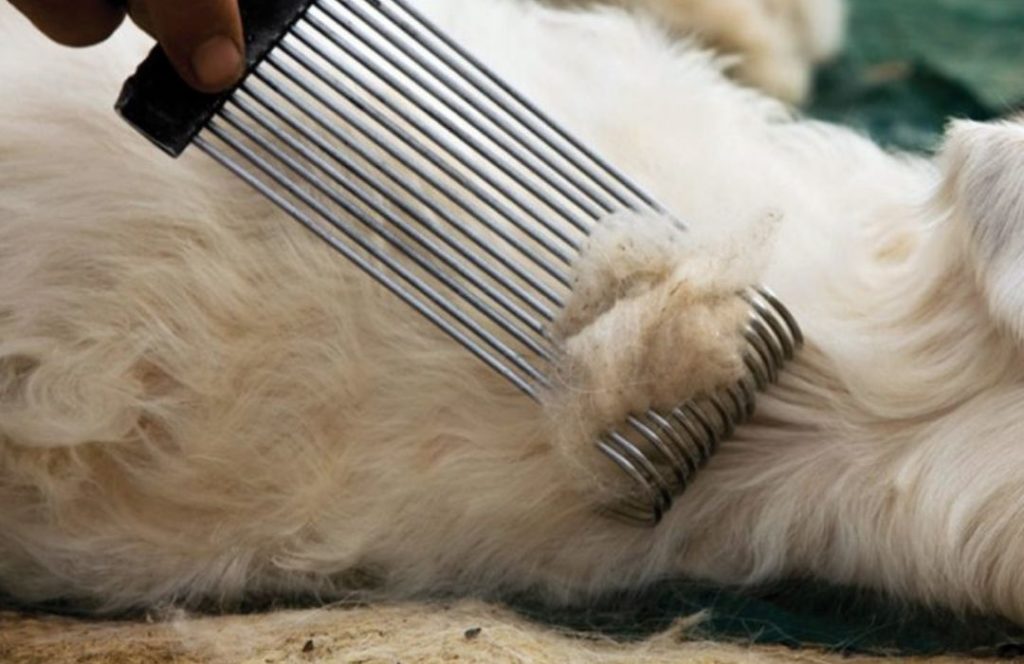
The process of obtaining cashmere begins during the spring moulting season when the goats naturally shed their undercoat. Herders then collect this delicate wool painstakingly through shearing or combing. It is this fine undercoat that the precious cashmere fibres come from.
Cashmere is popular for its ability to provide exceptional warmth without the bulk associated with many other insulating materials. Fine fibres have the unique property of trapping heat efficiently. Hence it makes cashmere an ideal choice for cold-weather clothing and accessories.
Furthermore, cashmere is highly famous for its versatility. Artisans can handweave it into a wide range of products, including scarves, sweaters, shawls, blankets, and more. These products are not only famous for their comfort and warmth but also for their timeless elegance and style.
History of Cashmere
The history of Cashmere is a rich tapestry that spans centuries and encompasses various cultures and regions. Cashmere, the soft and luxurious wool that comes from the undercoat of cashmere goats, has been highly popular for its exceptional qualities. Here's a brief overview of the history of cashmere:
Ancient Origins
The story of cashmere begins in ancient Asia, particularly in the Himalayan region of Kashmir, where the cashmere goat was first domesticated. It was the early herders who discovered the incredibly soft wool from these goats. It was them who recognized its value.
Medieval and Renaissance Periods:
- Introduction to Europe: Cashmere made its way to Europe via trade routes, initially through the Silk Road. The wool quickly gained popularity among European aristocrats and the upper class for its softness and rarity.
- Renaissance Fashion: During the Renaissance period, cashmere garments became fashionable among European nobility. Cashmere shawls and scarves were highly popular luxury items, often gifted between royalty and nobility.
19th Century:
- Scottish Mills: In the early 19th century, Scottish textile mills began producing cashmere products, particularly shawls and scarves. These mills played a significant role in making cashmere more accessible to the European market.
20th Century:
- Mass Production: Cashmere production expanded further in the 20th century, with increased demand for cashmere products. Technological advancements in weaving allowed for more efficient mass production.
- High Fashion: Cashmere became synonymous with high fashion in the mid-20th century. Renowned fashion houses, such as Chanel and Burberry, incorporated cashmere into their collections, further elevating its status.
Modern Times:
- Global Production: Today, cashmere is produced not only in its traditional regions like Kashmir and Mongolia but also in countries like China, Scotland, and Italy. China, in particular, has become a major player in cashmere production.
- Sustainability: With a growing focus on ethical and sustainable practices, the cashmere industry has faced challenges related to overgrazing and environmental impact. However, currently, manufacturers are making huge efforts to promote responsible and sustainable cashmere sourcing.
- Global Demand: Cashmere remains highly sought after worldwide, with cashmere scarves, sweaters, and shawls being iconic fashion staples. Cashmere's association with luxury and comfort ensures its enduring popularity.
Uses of Cashmere Fabric
Cashmere fabric, famous for its exceptional softness and warmth, is a prized material. Hence, producers use it to create a wide range of luxurious and high-quality products. Its versatility, combined with its luxurious qualities, has indeed made it a sought-after choice for various items. Here's a look at some of the products made from cashmere fabric:
Cashmere Sweaters
Cashmere sweaters are perhaps the most iconic and popular cashmere product. Known for their unmatched softness and warmth, cashmere sweaters are a staple in many wardrobes. They come in various styles, from crewnecks to V-necks, and one can wear them for both casual and formal occasions.
Cashmere Scarves
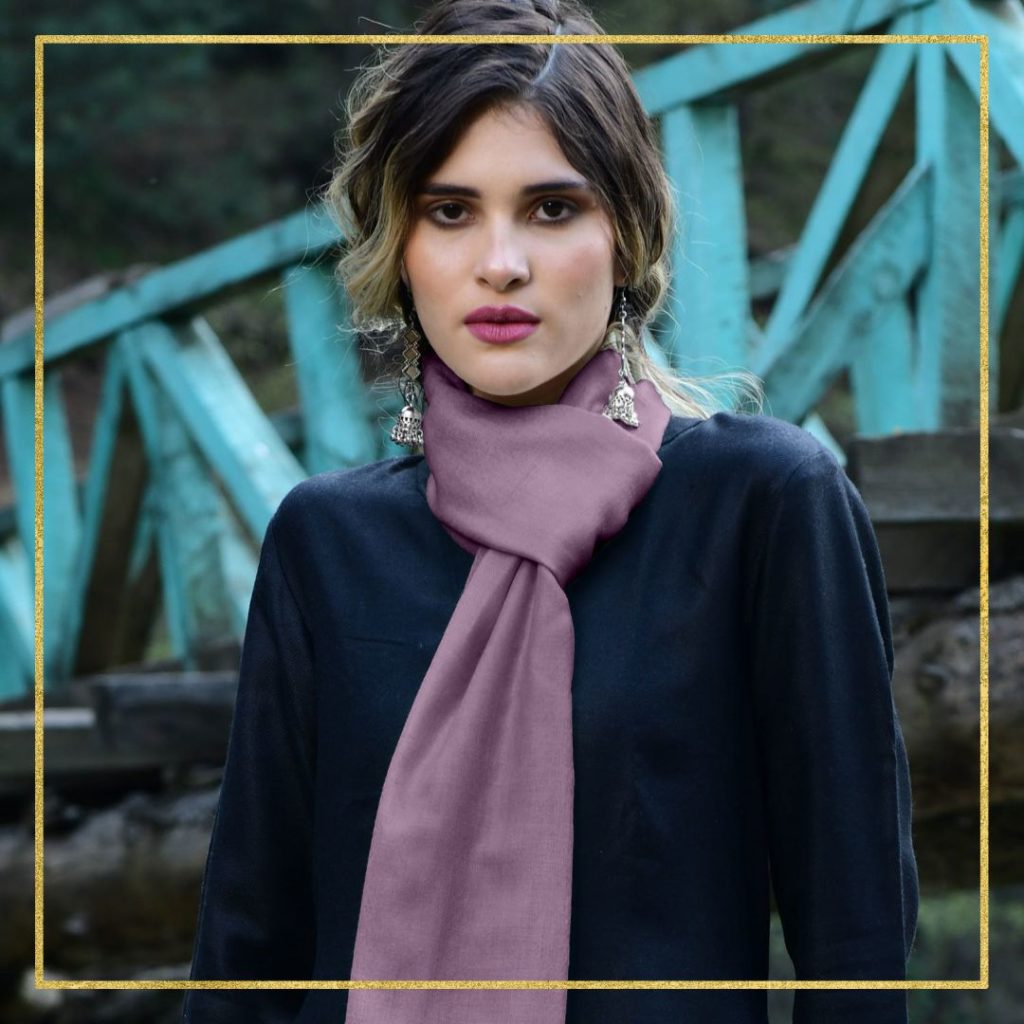
Cashmere scarves are popular for their ability to provide warmth and elegance. They are available in a multitude of colours and designs. This certainly makes them versatile accessories that can elevate any outfit.
Cashmere Shawls and Wraps
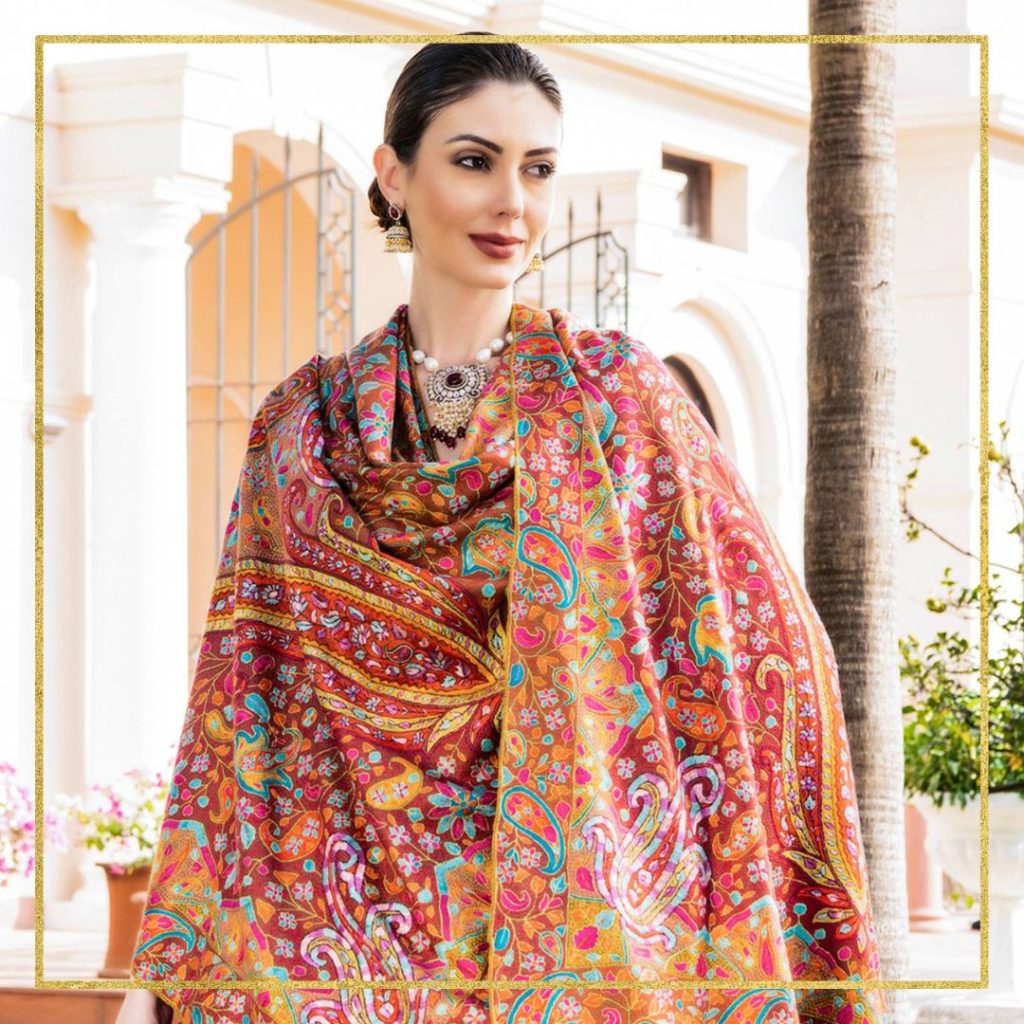
Cashmere shawls and wraps are larger than scarves and provide ample coverage. They are perfect for draping over the shoulders or wrapping around oneself on chilly evenings. These shawls often feature intricate designs and patterns, adding a touch of sophistication to any ensemble.
Cashmere Blankets and Throws
Cashmere blankets and throws are the epitome of luxury and comfort. One can use them to add warmth and style to sofas, beds, and chairs. Cashmere's softness against the skin makes these blankets ideal for snuggling up during the colder months.
Cashmere Socks and Slippers
Cashmere socks and slippers offer a cosy and indulgent experience for your feet. They keep your toes warm and pampered, making them a popular choice for lounging at home.
Cashmere Dresses and Skirts
Cashmere fabric can be used to create elegant and comfortable dresses and skirts. These garments combine the warmth of cashmere with fashionable designs, allowing you to stay stylish while staying cosy.
Cashmere Outerwear
Cashmere is also used in the construction of outerwear, such as cashmere coats and jackets. These items provide warmth and insulation, making them perfect for braving cold weather in style.
Cashmere Accessories
Cashmere is used in crafting various accessories, including gloves, mittens, and hats. These accessories keep your extremities warm while adding a touch of luxury to your winter ensemble.
Cashmere Bedding
Cashmere bedding sets, including sheets, pillowcases, and duvet covers, offer a sumptuous and comfortable sleeping experience. They are popular for their softness and insulating properties, ensuring a cosy night's rest.
Cashmere Baby Clothing
At times, Cashmere is used to create delicate and gentle clothing for infants and babies. Cashmere baby blankets, onesies, and sweaters are popular choices for newborns, offering warmth and comfort.
In addition to these products, makers also use cashmere in the creation of high-end fashion items, including designer dresses, suits, and accessories. Its ability to combine warmth, softness, and style makes cashmere a material of choice for those who appreciate quality and luxury.
Making of a Cashmere Shawl
The making of a cashmere shawl is a meticulous and highly skilled process. It involves several steps, each essential in crafting this luxurious and cherished accessory. Cashmere, famous for its exceptional softness and warmth, comes from the fine undercoat of cashmere goats. These goats primarily inhabit the regions like Mongolia, China, and Inner Mongolia. Here, we'll take you through the journey of creating a cashmere shawl.
Step 1: Sourcing and Shearing
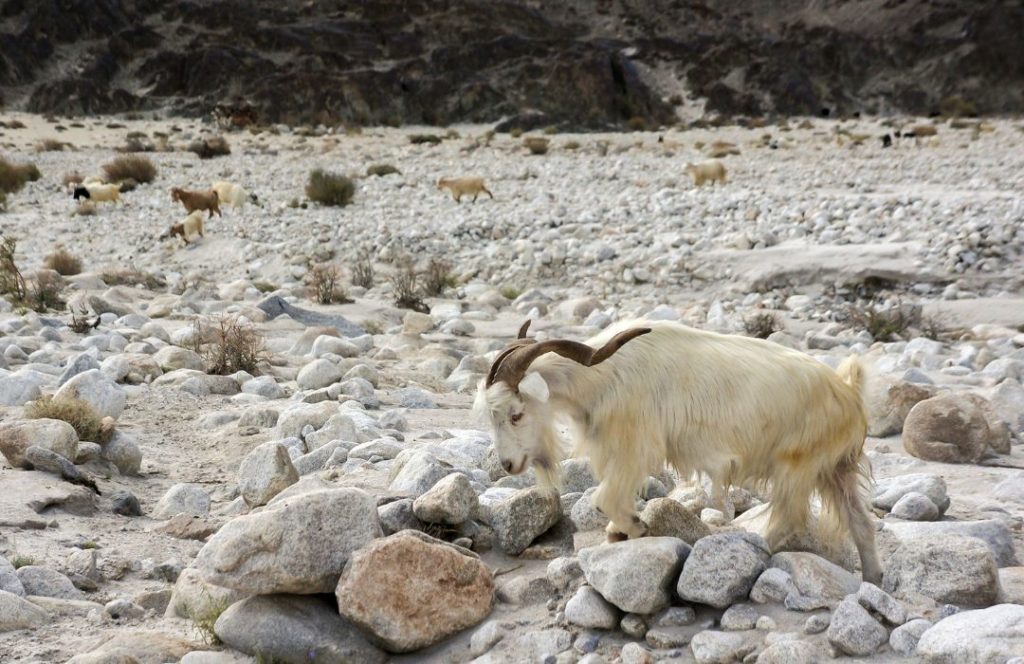
The process begins during the spring moulting season when cashmere goats naturally shed their undercoat. Farmers carefully and gently comb the goats to collect the valuable cashmere fibres. This step is crucial to ensure that the fibres are collected without causing harm to the animals. Herders carefully use specialised tools and professional techniques to gently comb out the fine undercoat of the goats.
Step 2: Sorting and Grading
After collection, artisans sort and grade the raw cashmere fibres. This involves separating the valuable fine undercoat from the coarser outer hair. Skilled workers carefully examine the fibres, feeling for softness and fineness, and remove any impurities. Usually, womenfolk of the Kashmir valley carry out this task, as they have decades of experience in this intricate and challenging process.
Step 3: Washing
It is again the womenfolk who wash the collected cashmere fibres thoroughly to remove dirt, grease, and any remaining impurities. This cleansing process is vital to prepare the fibres for further processing and ensure their cleanliness.
Step 4: Dehairing
To separate the cashmere fibres from the coarser outer hair, artisans carry out a process called dehairing. This is done using mechanical or chemical methods. Mechanical detailing involves passing the fibres through machines that separate the finer cashmere from the coarser fibres based on their diameter and length. Conversely, chemical dehairing uses a gentle chemical treatment to dissolve the outer hair, leaving behind soft cashmere fibres.
Step 5: Carding
Once dehairing is complete, artisans start carding the cashmere fibres. Carding is a challenging process that involves combing and aligning the fibres to create a uniform and fluffy mass of cashmere. This step helps in further removing any remaining impurities and aligning the fibres for spinning.
Step 6: Spinning
After carding, artisans manually spin the cashmere fibres into yarn. This process involves twisting the fibres together to create a continuous strand of yarn. The thickness and quality of the yarn are determined during this stage. However, it can vary depending on the desired end product. Spinning takes place over a traditional spinning wheel called Yinder locally. The meticulous womenfolk of Kashmir carry this process out for months together. Spinning transforms lumps of wool into fine yarn.
Step 7: Dyeing
At this stage, dyers can dye the yarn if the need arises. Natural and synthetic dyes can be used to achieve a wide range of colours. Artisans carry out this process carefully to preserve the softness and quality of the cashmere.
Step 8: Weaving
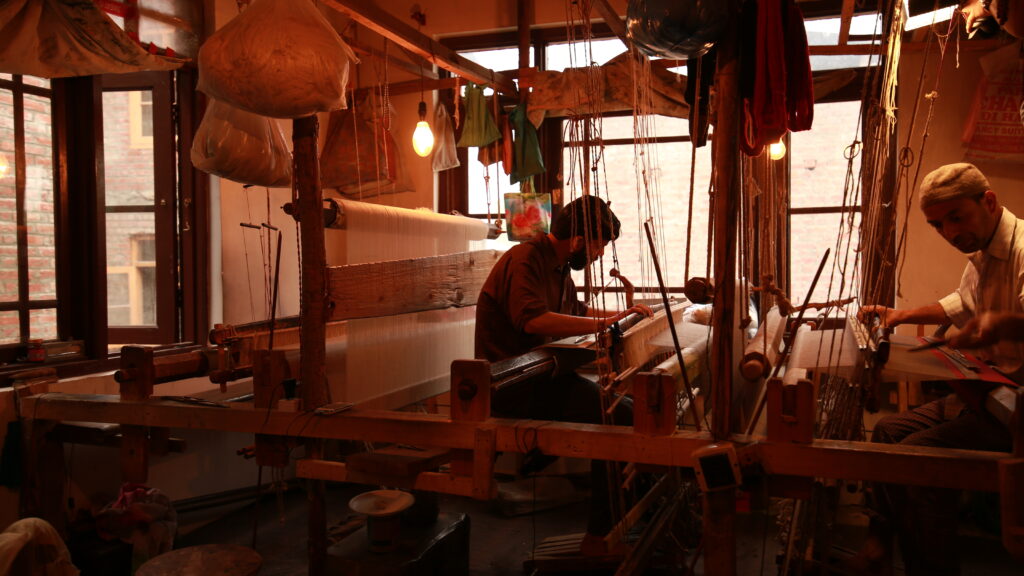
Artisans at this stage use spun and, if necessary, dyed cashmere yarn to weave the Cashmere shawl. Traditional hand-weaving techniques are used, depending on the desired outcome. Skilled artisans follow specific patterns or designs to create the intricate motifs often associated with cashmere shawls.
Step 9: Quality Control
Throughout the processing and manufacturing stages, professionals implement quality control measures. These measures ensure that the cashmere shawl meets the desired standards for softness, warmth, and overall quality. Any imperfections are corrected to maintain the integrity of the final product.
Step 10: Finishing Touches
After weaving or knitting, the cashmere shawl undergoes a series of finishing processes. It is carefully washed, stretched, and blocked to bring out its true beauty. Artisans correct any loose threads or imperfections meticulously, ensuring that the final product is a masterpiece.
Step 11: Packaging and Presentation
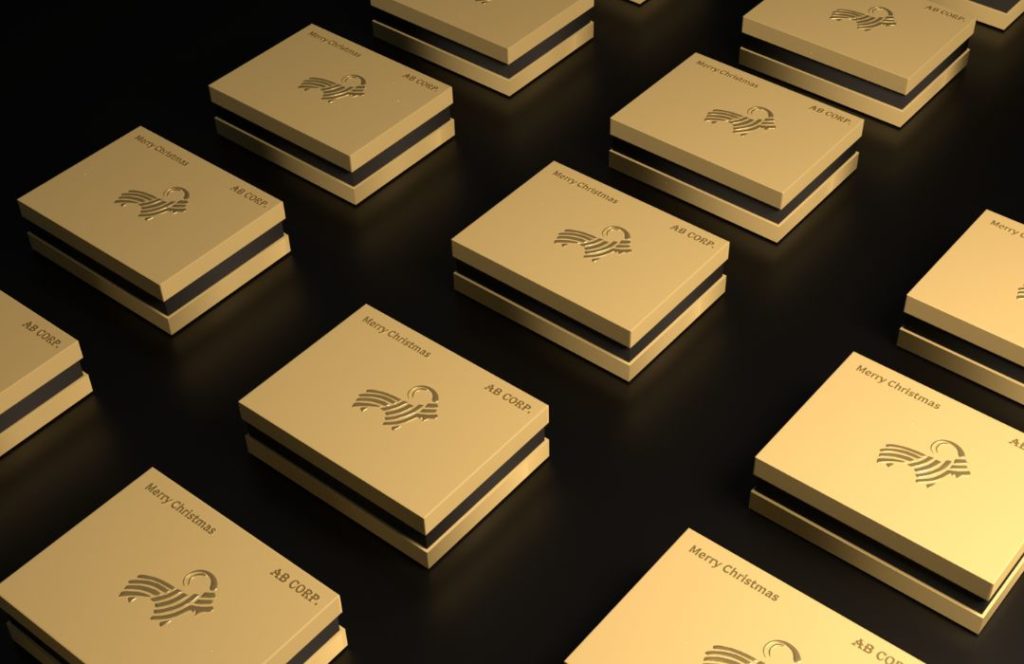
The finished cashmere shawls are carefully packaged and prepared for distribution. High-quality cashmere products often come with special packaging and labelling to showcase their premium quality and authenticity. Moreover, Cashmere shawls need special packaging which makes sure there is no growth of moisture in it.
Is Cashmere warm?
Cashmere scarves are indeed a treasured choice for staying warm and comfortable during winter days, and their popularity spans the globe for several compelling reasons. These exquisite accessories not only offer exceptional warmth but also elevate one's style, making them a preferred choice for people of diverse tastes and preferences.
First and foremost, the warmth provided by cashmere scarves is exceptional. The fine fibres of cashmere, sourced from the undercoat of cashmere goats, have a unique ability to trap warm air close to the body. This natural insulation ensures that even in frigid temperatures, you remain snug and cosy, shielding yourself from the biting cold.
What sets cashmere scarves apart is their unparalleled comfort. The luxurious softness of cashmere is a sensory delight, making it incredibly comfortable to wear. When draped around your neck or shoulders, a cashmere scarf feels gentle and soothing against your skin, offering a cocoon of comfort on chilly winter days.
Comfort and Style
Moreover, cashmere scarves are lightweight, adding to their appeal. Despite their remarkable warmth, they are not bulky or cumbersome. This lightweight nature allows you to effortlessly style and layer them with various outfits, whether you're dressing up for a formal occasion or opting for a casual, chic look. The versatility of cashmere scarves makes them an ideal accessory for individuals who want to combine style with comfort.
Furthermore, cashmere scarves are available in a wide array of colours, patterns, and designs. This diversity allows you to express your style and preferences, making it easy to find the perfect cashmere scarf to complement your winter wardrobe. Whether you prefer classic solids, intricate prints, or playful patterns, there's a cashmere scarf for everyone.
In summary, cashmere scarves are cherished for their exceptional warmth, unmatched comfort, lightweight nature, and versatile style. They provide the ideal combination of functionality and fashion, ensuring that you stay warm and stylish throughout the winter season. When you wrap yourself in a cashmere scarf, you not only shield yourself from the cold but also exude an air of sophistication and elegance, making it a beloved accessory cherished by people around the world.
Why are Cashmere Shawls warm?
Cashmere shawls are not just warm. They are exceptionally warm and popular for their ability to provide unparalleled comfort and cosiness, particularly during the colder months of the year. The remarkable warmth of cashmere shawls can be attributed to a combination of factors that make them the go-to choice for individuals seeking both style and comfort in winter.
Fine Fibre Diameter
Cashmere is derived from the fine undercoat of cashmere goats, which produce some of the thinnest and softest fibres in the world. These fibres typically measure between 12 to 15 microns in diameter, making them significantly finer than a human hair. This fineness allows cashmere to trap a substantial amount of warm air, creating a natural layer of insulation against the cold.
Natural Crimp
Cashmere fibres possess a natural crimp or waviness. This crimp structure generates tiny air pockets within the fibres, further enhancing their insulating properties. These air pockets act as barriers, preventing the escape of body heat and maintaining a cosy environment.
Exceptional Softness
The luxurious softness of cashmere is not just a tactile delight but also a functional advantage. When draped around the neck or shoulders, a cashmere shawl feels gentle and comforting against the skin. This softness adds to the overall warmth and comfort experienced by the wearer.
Lightweight and Bulk-Free
Despite their exceptional warmth, cashmere shawls are incredibly lightweight and lack the bulk associated with many other warm materials. This feature ensures that you can wear a cashmere shawl with ease and comfort, allowing for freedom of movement while staying warm.
Regulation of Body Temperature
Cashmere's breathability is another vital attribute contributing to its warmth. It efficiently regulates body temperature, keeping you warm in cold conditions and preventing overheating in milder weather. This versatility makes cashmere shawls suitable for various climates and seasons.
Durability
High-quality cashmere shawls are not only warm but also durable. With proper care, they can maintain their exceptional warmth and softness for many years, making them a wise investment in both style and functionality.
Stylish Versatility
Beyond their remarkable warmth, cashmere shawls are celebrated for their versatile style. They come in an array of colours, patterns, and designs, allowing wearers to express their individuality and adapt their cashmere shawls to various outfits and occasions. Whether you're attending a formal event or opting for a casual look, a cashmere shawl effortlessly enhances your style while keeping you warm.
Also read: HOW TO WEAR A CASHMERE SCARF IN WESTERN STYLE?
Conclusion
Cashmere shawls are not merely warm, they are the epitome of warmth and comfort. The combination of fine fibre diameter, natural crimp, exceptional softness, lightweight construction, and breathability makes them the perfect choice for staying cosy during winter. Their ability to provide warmth without compromising on style and versatility makes cashmere shawls a cherished accessory in wardrobes around the world. When you wrap yourself in a cashmere shawl, you experience the perfect blend of luxury, warmth, and elegance, making it an indispensable companion during chilly days.
Also read: WHAT IS CASHMERE USED FOR?